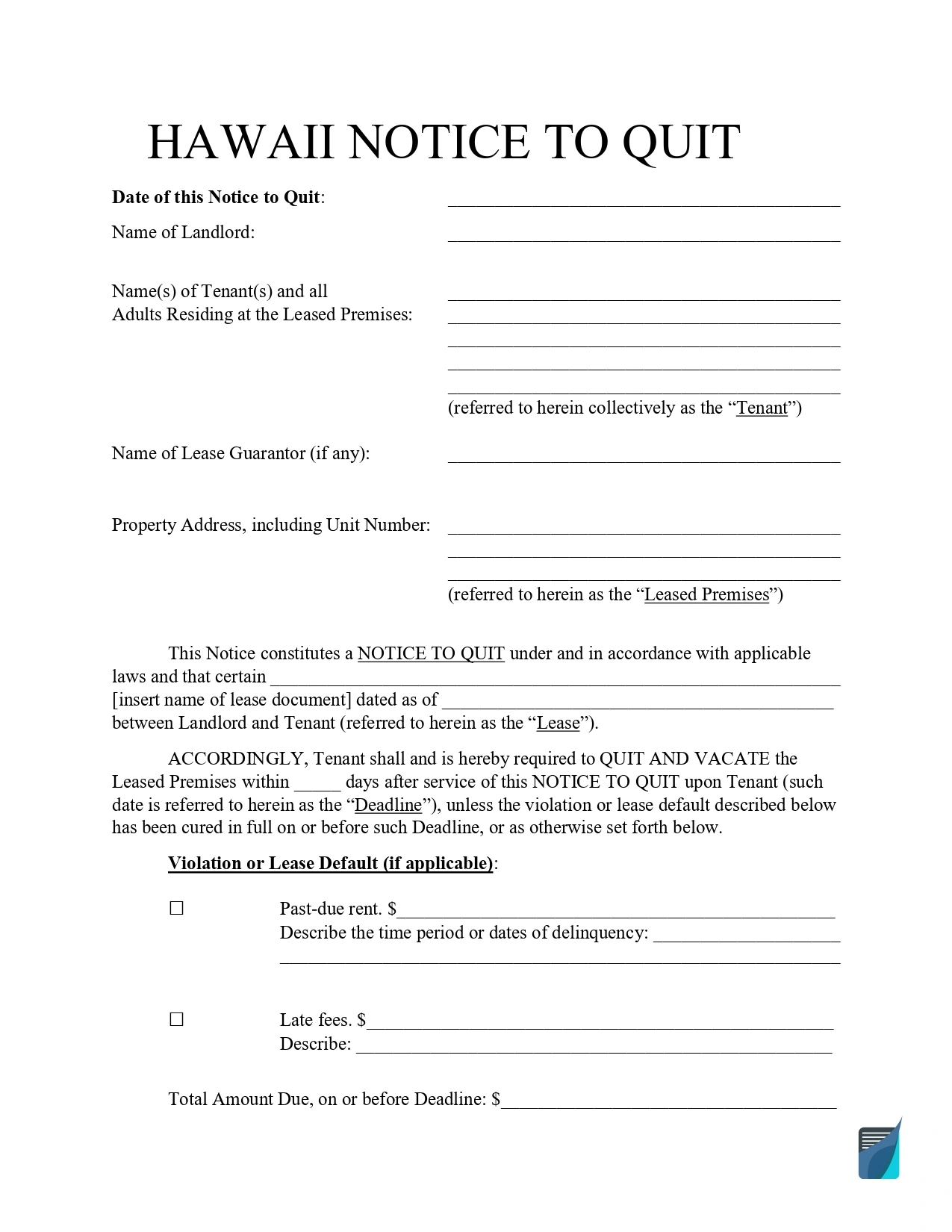Hawaii Eviction Notice Forms
The Hawaii eviction notice form is a legal document landlords must provide tenants to initiate the eviction process. This form is required when tenants violate their rental agreement terms or fail to pay on time.
The eviction notice’s specifics in Hawaii depend on the nature of the violation. For non-payment of rent, landlords must give a five-day notice to pay or vacate. For other lease violations, a ten-day notice is generally required. All eviction notice forms in Hawaii must clearly state the reason and the time frame the tenant must remedy the issue or vacate the property. If the tenant fails to comply with the notice, the landlord can file for eviction with the local court, seeking formal permission to remove the tenant.

Build Your Document
Answer a few simple questions to make your document in minutes
Save and Print
Save progress and finish on any device, download and print anytime
Sign and Use
Your valid, lawyer-approved document is ready
Hawaii Eviction Laws
The Hawaii Statutes govern eviction laws in this state, specifically Chapter 521, Part VI, which outlines remedies and penalties concerning residential tenancies. These laws provide a framework for landlords and tenants to understand their rights and responsibilities in eviction scenarios. Section 521-68, for example, details a landlord’s recourse when a tenant fails to pay rent. According to this statute, a landlord can demand rent payment any time after it’s due and issue a written notice giving the tenant at least five business days to pay or face tenancy termination.
Furthermore, Section 521-71 addresses the termination of a month-to-month tenancy. A landlord must provide a written notice at least 45 days before the anticipated termination date. Tenants are permitted to vacate the property within 45 days after receiving notice. Still, they must inform the landlord of their departure date and pay prorated rent for the period they occupy the unit.
In Hawaii, landlords are prohibited from forcibly reclaiming possession by withholding essential services like water or electricity, as outlined in Section 521-74.5. Such actions are deemed unfair and deceptive; penalties include damages up to three times the monthly rent or $1,000. If a tenant is unlawfully removed by a landlord without court approval, under Section 521-63, the tenant has the right to terminate the rental agreement. Additionally, they may seek compensation equivalent to two month’s rent, free occupancy for two months, and legal expenses.
Hawaii Eviction Notice Laws Details
| Rent Grace Period | Agreed to by the parties |
| Notice of Non-Payment | 5 days |
| Notice of Non-Compliance | 10 days |
| State Laws | Hawaii Revised Statutes, Sections 521-61 to 521-83 |
Eviction Notice Types Used in Hawaii
In Hawaii, the type of eviction notice issued depends on the violation incurred by the tenant.
Five-Day Notice to Pay Rent
This form is used when rent is overdue. The tenant has five business days after receiving the notice to pay the rent or face eviction proceedings.
Ten-Day Notice to Cure a Lease Violation
Under Section 521-72, if a tenant violates lease terms other than rent payment, the landlord can issue a ten-day notice requiring the tenant to remedy the breach or face eviction if the issue persists or recurs.
Forty-Five Day Notice to Terminate a Month-to-Month Tenancy
Landlords must give tenants at least 45 days’ notice when they intend to terminate a month-to-month lease. Tenants can move out sooner within this period if they notify the landlord and pay for the days they occupy the unit.

Popular Local Eviction Notice Forms
Eviction Process in Hawaii
The eviction process in Hawaii ensures fairness and due process by requiring landlords to follow specific steps.
Issuance of Notice
Initially, the landlord must provide the appropriate notice based on the reason for eviction — non-payment of rent, termination of a month-to-month tenancy, or other lease violations.
Waiting Period
After the notice is given, there is a mandatory waiting period during which the tenant can rectify the issue, such as paying overdue rent, correcting a lease violation, or choosing to vacate the property.
Filing for Eviction
If the tenant fails to comply with the notice requirements, the landlord may file an eviction lawsuit, often referred to as a summary proceeding for possession. This step involves going to court, where both parties can present their case.
Court Hearing and Judgment
The court will hear the case, and if the landlord prevails, they will receive a judgment for possession of the property.
Eviction Enforcement
The final step is enforcing the eviction, which typically involves the sheriff or another authorized official removing the tenant from the property if they have not voluntarily left following the court’s judgment.

Use our document builder to customize any template on FormsPal to your preferences. Here is a number of some other widely-used Alaska forms we provide.